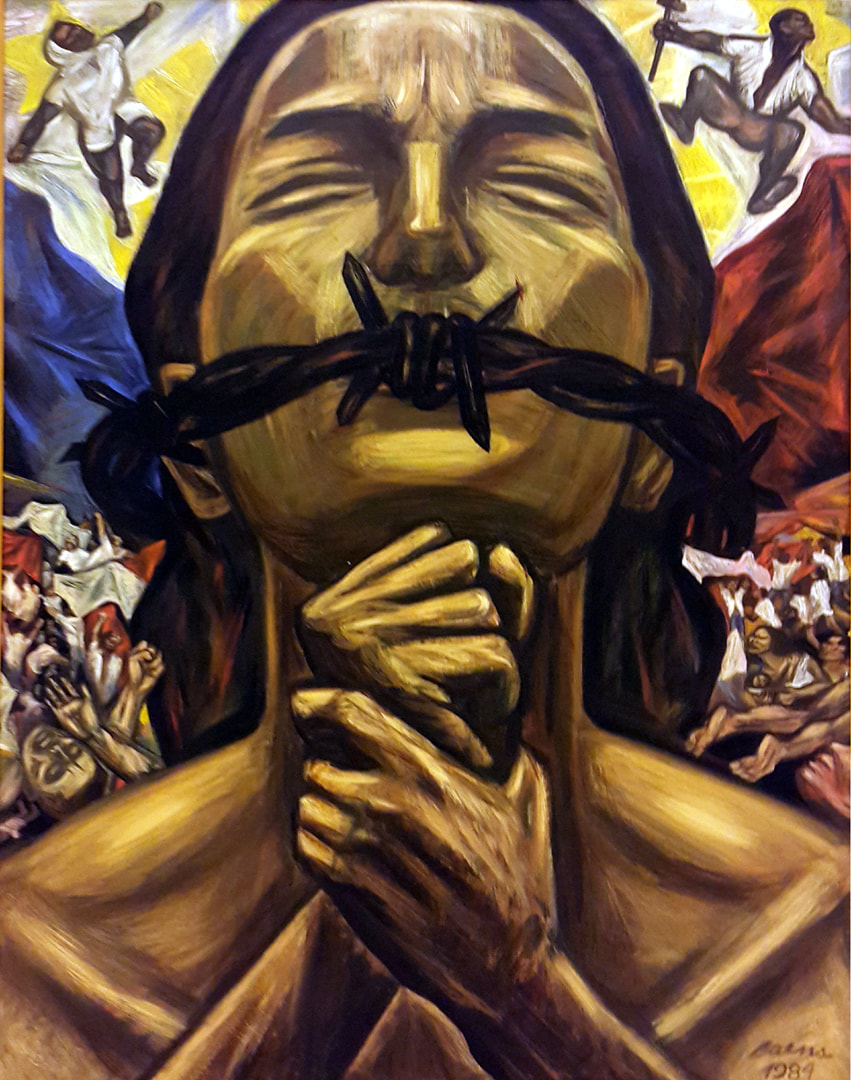Grade 11 Understanding Society: Visual Literacy & Social Realism
OBJECTIVES
- To be able to enhance learner’s visual literacy skills by encouraging them to pay attention to details of an artwork by analysing its composition
- To embolden learners to talk about what they think and feel about artworks with their peers
- To introduce Social Realism and art that reflects social realities
Introduction
Much like reading a book, artworks are also “read” through their visual language. Colours, symbols, shapes, subjects and how these are laid out carry their meaning and such details warrant thought and attention to be able to interpret an artwork. Furthermore, in some art styles, the historical, cultural and political context in which artworks are made also contribute to the richness of their expression. Some artworks are enjoyed for their intrinsic beauty. For others, political events or social realities that influenced the works necessitate understanding in order to appreciate these artworks more deeply.

Pablo Baen Santos
Krista
1984
Oil on canvas
Ateneo Art Gallery Collection
In order to have a meaningful engagement with artworks, it is important to spend time “reading” a painting by looking at it closely and lingering at the image. In this session, Pablo Baen Santos’ painting entitled Krista (1984) will be used to exercise learners’ visual literacy by analysing the composition of the painting. Being a social realist work, Krista will also be the focal point of the discussion on how social realities influence artworks.

Activity & Discussion
Time Frame
- 20-40 minutes
Materials
- notebook, pen/pencil, projector and screen
Process
- Depending on the class size and the teacher’s gauge of the students’ confidence in participating in class discussion, the teacher may either divide the class into smaller groups of no more than five (5) members each or facilitate an entire class discussion.
- It is recommended that the teacher reviews how to identify the foreground, middle ground and background of a painting before looking at the composition of the artwork.
- The high-resolution photograph of Pablo Baen Santos’ Krista is projected on screen or students are given full-colour print-outs of the image. Students are given ample time to look at details of the painting. To refrain from imposing its meaning on the learners, it is suggested that only the artist’s name, title of the work, year, medium and collection to which it belongs should be revealed.
- The high-resolution photograph of Pablo Baen Santos’ Krista is projected on screen or students are given full-colour print-outs of the image. Students are given ample time to look at details of the painting. To refrain from imposing its meaning on the learners, it is suggested that only the artist’s name, title of the work, year, medium and collection to which it belongs should be revealed.
- The students’ analysis of the painting’s composition is used to interpret the artwork. They discuss their answers with their group/seat mates and their thoughts about the following guide questions:
- What can you find in the foreground, middle ground and background of the painting?
- Where is the main subject of the work located? Who could she be?
- What details in the painting give us clues about her identity? Where are these details located?
- What other features of the painting contribute to its message? Where are they placed on the canvas?Note: There is no expected output from this exercise that will be marked. The objective is to encourage students to talk about an artwork with their peers.
- After giving the students ample time to discuss their opinions with their group/seat mates, the teacher facilitates a group sharing. Finally, the teacher synthesizes the points discussed and uses the content below to enrich the conversation.

About the Artist:
Pablo Baen Santos (b. 1943), a respected social realist painter, graduated from the University of the Philippines College of Fine Arts. After obtaining his degree, he worked as a layout artist, illustrator and photographer for the Manila Times and covered mass actions and protests in the early 1970s.[1] Being a witness to the struggle of ethnic minorities, labourers and the urban poor, he realized the social obligation of the artist to expose the true conditions of society.[2]
The artist’s socio-political orientation is manifest in his use of symbolism and common folk as subjects. Pablo Baen Santos questions the prevailing social order by baring the tensions in Philippine society between workers and capitalists, farmers and landowners and so on. Some of the icons he often uses in his paintings are the Philippine flag and Inang Bayan (Mother Country), both of which are imbued with meaning in the Philippine context.
About the Artwork:
Krista (1984) is an oil-on-canvas painting by Pablo Baen Santos featuring Inang Bayan in the centre-middle ground of the canvas, struggling to speak with thorns around her mouth. Two fists are positioned at the foreground of the painting; one is clasped around the wrist of the other clenched fist. At the background are the Philippine flag and human figures.
Here we see apparent symbolisms: (1) Inang Bayan, (2) thorns around the mouth, (3) clenched fists and (4) the Philippine flag. Juxtaposed with the Philippine flag, the subject symbolises the Mother Country in a state of unrest. The thorns around her mouth and the expression on her face suggest that her right to speak is infringed upon and that her liberties are curtailed. Lastly, because they are a instinctive gesture in protests and mass actions, raised fists have become a symbol of struggle and defiance.
There is an added reference to the subject being the female Christ or Krista, with thorns around her mouth instead of her head like Jesus Christ. In the Bible, Jesus Christ was crucified for crimes he did not commit. The painting’s reference to Christ connotes the unjust suffering of Filipinos.
What was happening in 1984?
Martial Law was lifted in September 17, 1981, but freedom and democracy were not truly restored. For instance, filmmakers and playwrights were still required to submit their scripts to the Board of Censors for approval. Three years after the supposed lifting of Martial Law, Lino Brocka’s film Bayan Ko: Kapit sa Patalim (1984) was not allowed by the Board of Censors to be shown in the Philippines. Turing, the protagonist in the film, is caught between the dilemma of joining a labor union and complying to the waiver he signed stating that he is not part of one. Bayan Ko was screened at the Cannes Film Festival in 1984 and eventually, the Supreme Court approved its release in the Philippines.
This issue sparked outrage among artists in varied disciplines like film, theater, music, visual arts and dance. During this time, artist groups like Concerned Artists of the Philippines (CAP) were formed to raise the concerns of Filipino artist. Pablo Baen Santos was a founding member of this organization.
[1] ArtSpeak with featured Artists in ‘Ligalig: Art in a Time of Turmoil’, YouTube video, 2:17:52, posted by Ateneo Art Gallery, 7 June 2017.
[1] Alice Guillermo, Social Realism in the Philippines, (Manila: Asphodel, 1987) pp.


